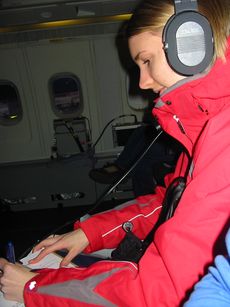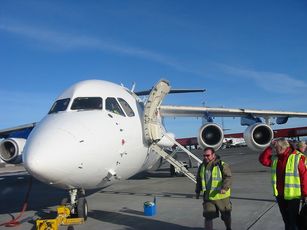

|
|
|||
|
|
|||
|
|
|||
|
|
|||
|
|
|||
|
|
|||
|
|
|||
|
|
|||
 |
|||
Saturday 24th February - SAP Flight |
The aim of today’s mission: to improve Sunday and Monday’s weather forecasts over the UK, by incorporating data from dropsondes released during the mission into the 12Z Met Office forecast. The decision to fly this mission was taken on viewing so-called sensitive area predictions, provided by both Met Office and ECMWF. Thanks to their continued hard work, we are receiving these every 12hrs for the duration of GFDex. Sensitive area predictions are plots of the North-Atlantic European region showing us where we should make additional observations in order to improve the forecast over the UK. Such areas are termed sensitive. Using these plots we planned to drop sondes into the sensitive region south of Iceland, using ‘lawnmower’ pattern shown on the flight track. It wasn’t until we got halfway through the flight that the captain realised we could have saved 30 minutes of flight time by using a zigzag pattern instead of the ‘lawnmower’ pattern we were executing! To achieve our aim we needed the dropsonde data transmitted from the aircraft to arrive at the Met Office by the cut-off time of 2:40pm. This meant an early start for all: flight briefing at 6:45am, transport to the aircraft at 7:10am and take-off at 9am. The early start, combined with no exciting low-level flying, and the length of the flight put most people off flying, so we set off with only four scientists (Ian, Emma, Dave and Shunli) and one Canadian journalist in addition to the normal crew. |
||||
We were rewarded for getting up early by clear skies around south-west Iceland, ensuring stunning views and much photo-taking, before we released the first dropsonde and turned away from Iceland where our view downwards quickly became obscured by low-level cloud. The flight went smoothly, with all dropsondes working perfectly, and the data being transmitted onto the global transmission system and to the Met Office in record time by dropmaster Stuart. The only problems we encountered were due to flying at high-altitude for over 5 hours - the back of the plane got cold enough during the flight for water to freeze in the sink in the bathroom and Stuart, dressed in shorts and t-shirt, to have to borrow heat pads from flight-manager Allan to warm his feet up! On returning to Keflavik we were informed that we were record-breakers - with a total flight time of 5h 49m 14s, this is the longest science flight flown by FAAM! At the hotel the scientists were greeted with news of the possibility of a similar flight on Monday, and so flight planning which had begun in their absence continued into the evening. At least one extremely tired scientist had her day made, when in the early evening, we received news from the Met Office confirming that our data had made it into that day’s weather forecasts. Whether these forecasts have been improved as a result of the additional data we collected will not be clear until the scientists return to the UK and perform the necessary experiments. |
||||

